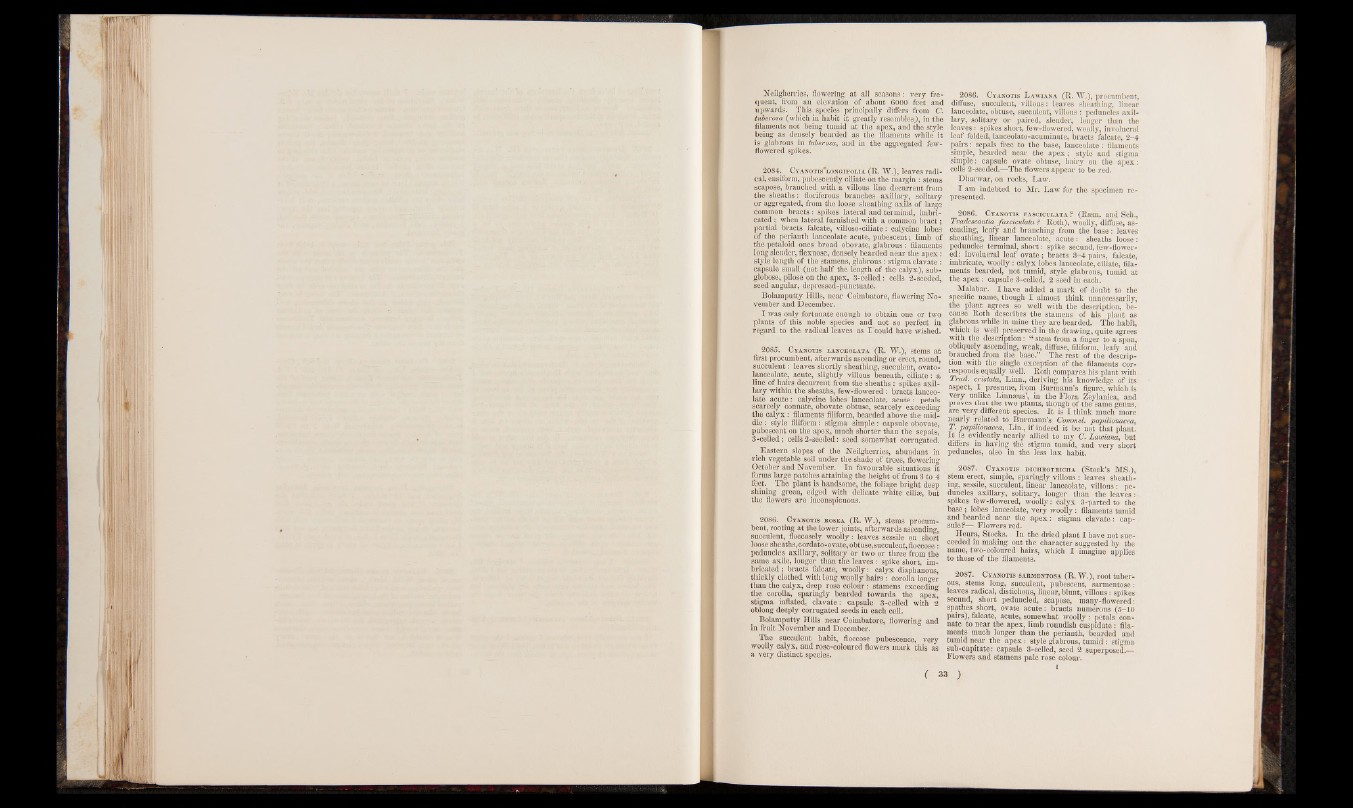
Neilgherries, flowering at all seasons: very frequent,
from an elevation of about 6000 feet and
upwards. This species principally differs from C.
tnberosa (which in habit it greatly resembles.), in the
filaments not being tumid at the apex, and the style
being as densely bearded as the filaments while it
is glabrous in luberosa, and in the aggregated few-
flowered spikes.
2084. Cyanotis*eongifoeia (R. W.), leaves radical,
ensiform, pubescently ciliate on the margin: stems
scapose, branched with a villous line decurrent from
the sheaths: floriferous branches axillary, solitary
or aggregated, from the loose sheathing axils of large
common bracts : spikes lateral and terminal, imbricated
; when lateral furnished with a common bra&t;
partial bracts falcate, vilioso-ciliate: calycine lobes
of the perianth lanceolate acute, pubescent; limb of
the petaloid ones broad obovate, glabrous: filaments
long slender, flexuose, densely bearded near the apex:
style length of the stamens, glabrous: stigma clavate:
capsule small (not half the length of the calyx), sub-
globose, pilose on the apex, 3-celled: cells 2-seeded,
seed angular, depressed-punctuate.
Bolamputty Hills, near Coimbatore, flowering N ovember
and December.
I was only fortunate, enough to obtain one or two
plants of this noble species and not so perfect in
regard to the radical leaves as Tcould have wished.
2085. Cyanotis lanceolata (R. W.), stems at
first procumbent, afterwards ascending or erect, round,
succulent: leaves shortly sheathing, succulent, ovato-
lanceolate, acute, slightly villous beneath, ciliate: a
line of hairs decurrent from the sheaths: spikes axillary
within the sheaths, few-flowered: bracts lanceolate
acute: calycine lobes'lanceolate, acute: petals
scarcely connate, obovate obtuse, scarcely exceeding
the c a lyx: filaments filiform, bearded above the middle
: style filiform: stigma simple: capsule obovate,
pubescent on the apex, much shorter than the sepals,
3-celled; cells 2-seeded: seed somewhat corrugated.
t Eastern slopes of the Neilgherries, abundant in
rich vegetable soil under the shade of trees, flowering
October and November. In favourable situations it
forms large patches attaining the height of from 3 to 4
feet. The plant is handsome, the foliage bright deep
shining green, edged with delicate white cilise, but
the flowers are inconspicuous.
2086. Cyanotis rosea (R. W.), stems procumbent,
rooting at the lower joints, afterwards ascending,
succulent, floccosely woolly: leaves sessile on short
loose sheaths, cordato-ovate, obtuse,succulent, floccose:
peduncles axillary, solitary or two or three from the
same axile, longer than the leaves: spike short, imbricated;
bracts falcate, woolly: calyx diaphanous,
thickly clothed with long woolly h a irs: corolla longer
than the calyx, deep rose colour: stamens exceeding
the corolla, sparingly bearded towards the apex,
stigma inflated, clavate: capsule 3-celled with 2
oblong deeply corrugated seeds in each cell.
Bolamputty Hills near Coimbatore, flowering and
in fruit November and December.
The succulent habit, floccose pubescence, very
woolly calyx, and rose-coloured flowers mark this as
a very distinct species.
2086. Cyanotis L awiana (R. W .), procumbent,
diffuse, succulent, villous: leaves sheathing, linear
lanceolate, obtuse, succulent, villous: peduncles axillary,
solitary or paired, slender, longer than the
leaves: spikes short, few-flowered, woolly, involucral
leaf folded, lanceolato-acuminate, bracts falcate, 2-4
pairs: sepals free to the base, lanceolate: filaments
simple, bearded near the ap e x ; style and stigma
simple: capsule ovate obtuse, hairy on the apex:
cells 2-seeded.—The flowers appear to be red.
Dharwar, on rocks, Law.
I am indebted to Mr. Law for the specimen re presented.
2086. Cyanotis fascicueata ? (Rsem. and Sell.,
Tradescantia fasciculata ? Roth), woolly, diffuse, ascending,
leafy and branching from the base: leaves
sheathing, linear lanceolate, acute: sheaths loose:
peduncles terminal, sh o rt: spike secund, few-flowered:
involucral leaf ovate; bracts 3-4 pairs, falcate,
imbricate, woolly: calyx lobes lanceolate, ciliate, filaments
bearded, not tumid, style glabrous, tumid at
the ap e x : capsule 3-celled, 2 seed in each.
Malabar. I have added a mark of doubt to the
specific name, though I almost think unnecessarily,
the plant agrees so well with the description, because
Roth describes the stamens of his plant as
glabrous while in mine they are bearded. The habit,
which is well preserved in the drawing, quite agrees
with the description: “ stem from a finger to a span,
obliquely ascending, weak, diffuse, filiform, leafy and
branched from the base.” The rest of the description
with the single exception of the filaments corresponds
equally well. Roth compares his plant with
Trad, cristata, Linn., deriving his knowledge of its
aspect, I presume, from Burmann’s figure, which is
very unlike Linnaeus’, in the Flora Zeylanica, and
proves that the two plants, though of the same genus,
are very different species. I t is I think much more
nearly related to Burmann’s Commel. papilionacea,
T. papilionacea, Lin., if indeed it be not that plant.
I t is evidently nearly allied to my C. Lawiana, but
differs in having the stigma tumid, and very short
peduncles, also in the less lax habit.
2087. Cyanotis dichrotricha (Stock’s MS.),
stem erect, simple, sparingly villous: leaves sheathing,
sessile, succulent, linear lanceolate, villous: peduncles
axillary, solitary, longer than the leaves :
spikes few-flowered, woolly: calyx 3-parted to the
base; lobes lanceolate, very woolly: filaments tumid
and bearded near the ap e x : stigma clavate: capsule?—
Flowers red.
Heura, Stocks. In the dried plant I have not succeeded
in making out the character suggested by the
name, two-coloured hairs, which I imagine applies
to those of the filaments.
2087. Cyanotis sarmentosa (R.W.), root tuberous,
stems long, succulent, pubescent, sarmentose:
leaves radical, distichous, linear, blunt, villous: spikes
secund, short peduncled, scapose, many-flowered:
spathes short, ovate acute: bracts numerous (5-10
pairs), falcate, acute, somewhat woolly : petals connate
to near the apex, limb roundish cuspidate: filaments
much longer than the perianth, bearded and
tumid near the ap e x : style glabrons, tumid : stigma
sub-capitate: capsule 3-celled, seed 2 superposed.—
Flowers and stamens pale rose colour.
c 33 )